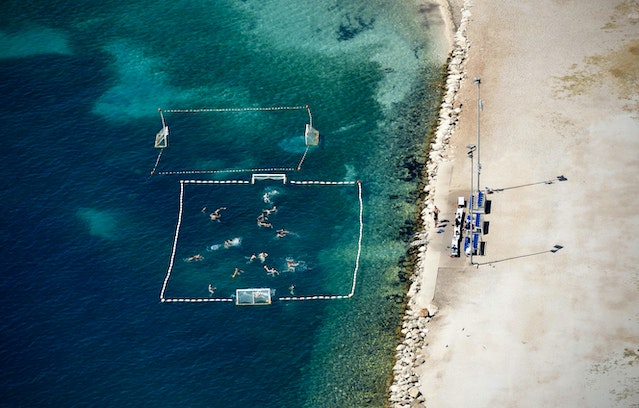Water polo is a popular and intense sport that requires a large pool to play in. For those who are unfamiliar with the sport, it may be difficult to imagine just how big the playing area is. The dimensions of a water polo pitch are regulated by the International Swimming Federation (FINA) and must adhere to specific measurements to ensure fair play.
For a water polo match, the pool must have a minimum depth of 2 meters (6.5 feet) and a length of 30 meters (98 feet) between goals, with a width of 20 meters (65 feet). The distance between goalposts is 3 meters (9.8 feet), and the crossbar must be at least 0.9 meters (3 feet) above the water’s surface. Nets are attached to the goalposts to catch the ball when a goal is scored.
Dimensions of a Water Polo Pitch
Length and Width
The size of a water polo pitch can vary, but there are some general guidelines that are followed. According to FINA and USA Water Polo, the length of the pool must be more than 20 meters but less than 30 meters for men, and less than 25 meters for women. The width of the playing field can vary from 10 to 20 meters.
Water polo pitches are rectangular in shape, with a length that is greater than the width. The exact dimensions of the pitch are determined by the size of the pool, but the length should always be greater than the width.
Depth
The depth of a water polo pitch must be at least 1.8 meters or 6 feet. This is to ensure that the players are not at risk of hitting their heads on the bottom of the pool. A deeper pool also allows for more vertical movement, which is important in water polo.
Goal Size
The goal size is an important aspect of a water polo pitch. The height of the goal must be 0.9 meters or 3 feet, and the width of the goal must be 3 meters or 9.84 feet. The goal is positioned at the center of each end of the pitch.
The goals are made of metal and are supported by a floating frame. The netting is attached to the frame and is designed to catch the ball when it is thrown into the goal.
The goalkeepers are the only players who are allowed to touch the ball with their hands, and they are responsible for defending the goal.
Markings on a Water Polo Pitch
A water polo pitch is a rectangular playing area that is divided into different zones, each marked with specific lines and markings. Understanding these markings is crucial for players, officials, and spectators to follow the game easily. Here are the different markings on a water polo pitch:
Centre Line
The centre line divides the pitch into two equal halves. It runs from one end of the pitch to the other and is marked in white. The centre line is used to start and restart the game, and it is also used to determine which team gets possession of the ball after a goal is scored.
Goal Line
The goal line is the line that runs across the width of the pitch at each end. It is marked in red and is located two metres from the end of the pitch. The goal line is the most important line on the pitch as it determines whether a goal has been scored or not.
2-Metre Line
The 2-metre line is a white line that runs parallel to the goal line, two metres away from it. It marks the area where defenders can defend their goal and restrict the movement of the attacking players. An attacking player cannot shoot from within the 2-metre area unless they are fouled by a defender.
5-Metre Line
The 5-metre line is a white line that runs parallel to the goal line, five metres away from it. It marks the area where a penalty shot is taken when a defender fouls an attacking player within the 5-metre area. The attacking player takes the penalty shot from this line.
Corner Throw Markings
The corner throw markings are located at each corner of the pitch, and they are marked in yellow. When the ball goes out of bounds behind the goal line, the team that did not touch the ball last is awarded a corner throw. The corner throw is taken from the corner throw marking.
Other Considerations
Pool Shape
Water polo pools come in different shapes, but the most common ones are rectangular. The pool’s dimensions are regulated to ensure fairness in competitions.
The pool size for men’s games is 30 meters long by 20 meters wide, with a depth of at least two meters. Women’s games are played on a smaller pool that measures 25 meters long by 17 meters wide, with the same depth as the men’s pool.
Lighting
Lighting is an essential factor in water polo games, especially during indoor competitions. Adequate lighting ensures that players can see the ball and their teammates clearly.
The lighting system should be positioned to avoid creating shadows on the pool’s surface, which can affect the players’ visibility. The lighting should also be bright enough to allow the referees to make accurate calls.
Water Temperature
The water temperature in water polo games can have an impact on the players’ performance. The water temperature should be between 25-27°C (77-81°F) to ensure that players are comfortable and can perform at their best.
If the water temperature is too low, players may experience muscle cramps, while high temperatures can lead to dehydration and exhaustion. The water temperature should be monitored regularly to ensure that it remains within the recommended range.
Overall, water polo games require a pool that meets specific regulations and considerations, such as pool shape, lighting, and water temperature. These factors ensure that players can perform at their best and that competitions are fair and safe.







